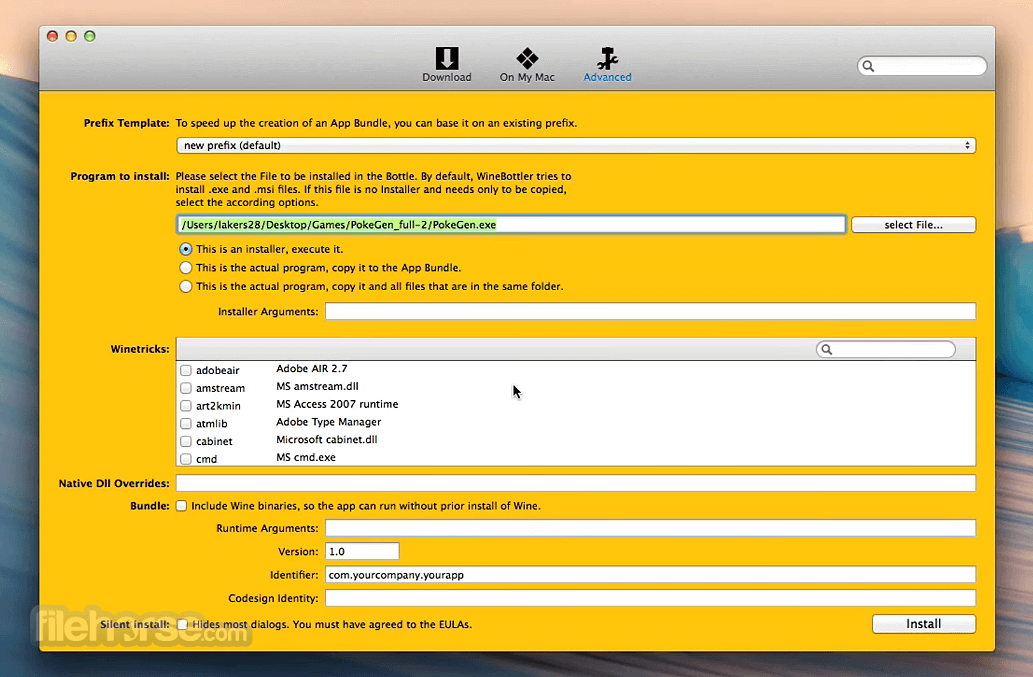
If you are using one of those products, please retest in plain Wine before filing bugs, submitting AppDB test reports, or asking for help on the forum or in IRC. Third party versions of Wine, such as Wineskin, Winebottler, and PlayOnMac, are not supported by WineHQ. There is no need to set DYLD_* environment variables all paths are relative, so it should work as long as the directory structure is preserved (you can skip the /usr prefix though using -strip-components 1).
#WINEBOTTLER INSTALL#
To install from a tarball archive, simply unpack it into any directory. For user convenience, the package also associates itself with all *.exe files, which means you can run windows executables just by double-clicking on them. from the Terminal, as the PATH variable is set correctly.

You can now directly start wine/winecfg/. By clicking on it, a new Terminal window opens with a short introduction into some important wine commands. After the installation is finished, you should find an entry "Wine Staging" or "Wine Devel" in your Launchpad. It is possible to install the package either for all users (needs administrator privileges), or just for your current user. pkg file, double-click on the package, and the usual macOS installer wizard should open. pkg file is recommended for inexperienced users.

pkg files and tarball archives are available at. Gatekeeper must not be set to block unsigned packages.īoth.Note that work is being done to convert core modules of WINE to PE format which will allow WINE to work on newer versions of macOS in the future. Please test these packages and report any bugs at. After that, it is necessary to drag the icons for WineBottler. Official WineHQ packages of the development and stable branches are available for macOS 10.8 to 10.14 (Wine won't work on macOS Catalina 10.15 as 32-bit x86 support is required). In order to install WineBottler, you must double-click the DMG file you have just downloaded. Note: Files in this directory are unused on macOS unless you use a UNIX window manager and other X11 applications instead of the native MacOS apps. Check the hidden directory `$HOME/.local/` where Wine stores some desktop menu entries and icon files as it interoperates with the X.Org Foundation and the Free Desktop.Clean-up pseudo C: drive and registry entries as well as all programs installed to C:.
#WINEBOTTLER CODE#
Then simply delete your local Wine source code directory: Otherwise and if you used `sudo make install`, revert it: Replace wine with wine-devel if you installed the development version. Sudo port uninstall -follow-dependencies wine Using MacPorts, uninstall the wine package you previously installed: See Building Wine on macOS Uninstalling Wineīrew uninstall -cask (selected wine package) The -no-quarantine line is to avoid brew adding the quarantine flag.

The advantage of installing via homebrew means wine is available from a standard terminal session Wine-stable, wine-devel or wine-staging packages can be installed using the above example. To install wine the following command can be used īrew install -cask -no-quarantine (selected wine package) Winehq packages can be installed using homebrew So now you know, if you need an application that is only on Windows, you may be able to save yourself the task of looking for a computer with the Microsoft system or installing BootCamp thanks to WineBottler.Translations of this page: Français (Translators, please see Discussion page.)
#WINEBOTTLER SOFTWARE#
This software has a really simple way of working, only indicating the application that we want to install and where it can be found, WineBottler will start up, it will help us to install it and launch it without problems.
#WINEBOTTLER PROFESSIONAL#
With WineBottler we'll be able to open programs like games, or professional software. This software is nothing more than an interface for the renowned Wine, thanks to which it's possible to launch more than 13,000 compatible Windows applications on a macOS. The truth is that the majority of times there is equivalent software, but they are never the same as the original. Even though Mac users are growing quicker each day, there are still many programs that are impossible to find outside of Windows.


 0 kommentar(er)
0 kommentar(er)
